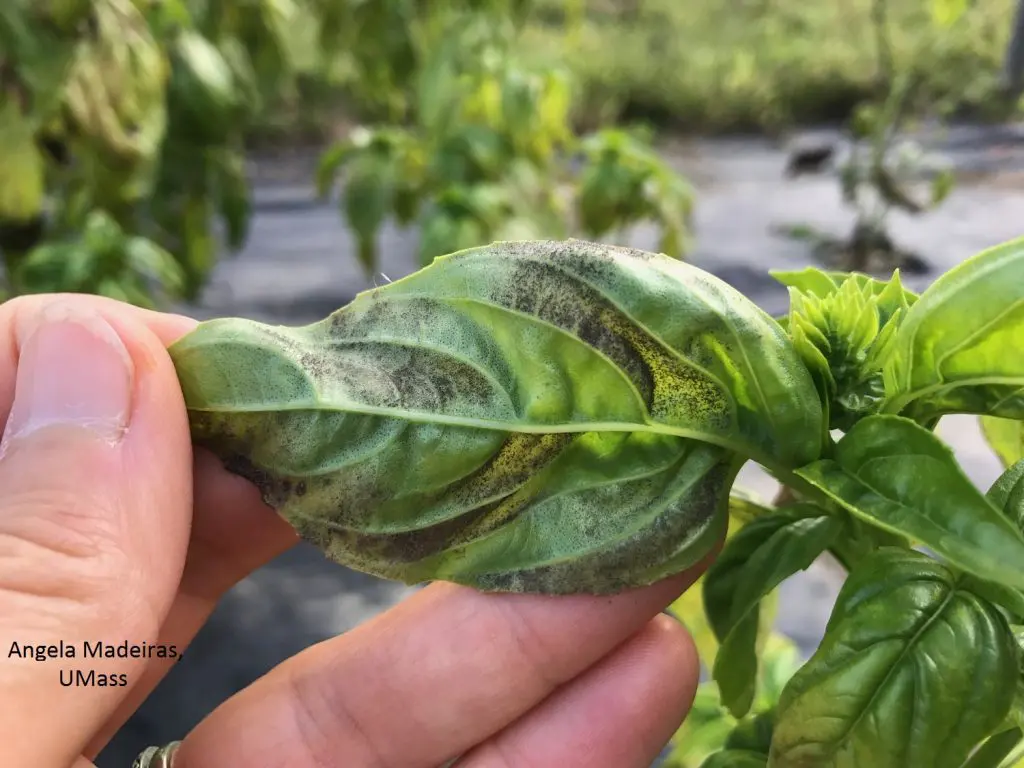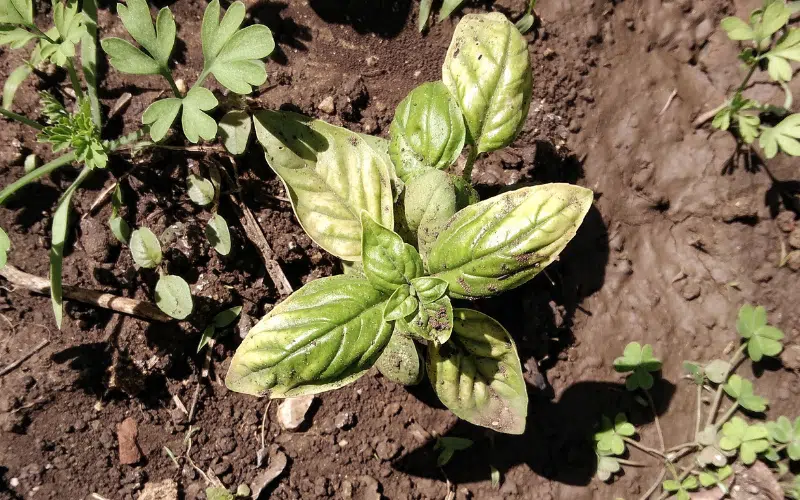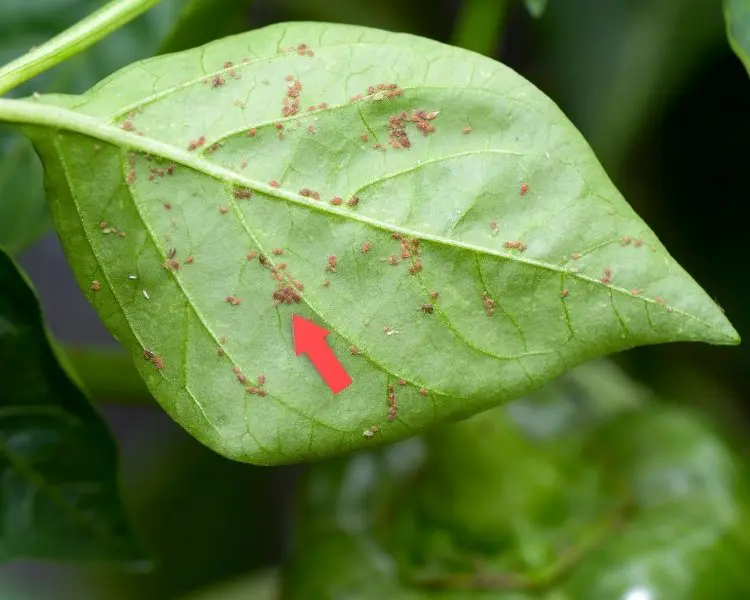I’ve been growing basil for a few months now. I love the smell of it when you walk by, and the taste is fantastic as well! However, one day I noticed that some of the leaves are starting to turn yellow and fall off. What could be causing this? Is there anything I can do about it?
Basil is pretty easy to grow and a great way to get starting with indoor gardening. But there are a few common problems with growing basil, and one of the main issues is with basil leaves turning yellow.
Why are your basil turning leaves yellow?
Let’s start with the basics. Basil plants (and all plants) need 4 things to be successful:
- Water
- Light
- Heat
- Oxygen
When you give too much or too little of any of those 4, you can run into problems.
8 Reasons Your Basil is Turning Yellow
Keeping those 4 things in mind, here are 8 common causes of yellowing leaves.
1. Overwatering Causing Root Rot
Overwatering is the most common problem and cause of yellow leaves. Overwatering leads to root rot, and the yellow leaves are a sign from the basil plant that let you know this is happening.
While you might be tempted to water your basil every day, that is often not necessary and you’ll end up with overly moist soil.
Check the soil about an inch down with your finger and see if you can feel moisture. If not, it’s probably save to water them.
Overwatering basil is often a problem when planting basil indoors vs outdoors, as the soil in a typical outside garden has better drainage that an indoor container or pot.
Oxygen (#4 on our plant requirements list) is compromised when you overwater your plants. Plants breathe through their roots, and when they are submerged in water for an extended period of time, the basil plant’s roots can’t get enough oxygen.
The Fix:
Try bottom watering your basil plant or using a spray bottle for a few days instead of the faucet or a watering can. You’ll be less likely to overwater the basil plant.
While the soil may look dry on top, if you stick your finger into the soil, you’ll often hit moisture, which means the roots are still wet and you can probably skip a day of watering. You should start to see some green come back in and replace the yellow part of the leaves.
2. Not Enough Water
On the flip side, if you aren’t watering your plant enough, the basil plant will let you know by the leaves starting to wilt. But this generally wont cause the leaves to turn yellow, unless of course you let it go for a very long time.
The Fix:
Don’t let your soil get too dry!
3. Not Enough Heat
As with most plants, basil plants need adequate lighting and temperature.
The ideal temperature for basil to grow is between 77 and 85 degree Fahrenheit.
If you leave your basil plants in a room that is under 60-65 degrees Fahrenheit, after 2 or 3 days the leaves will start turning yellow. If you keep your house cold, or have the basil sitting near a drafty window, this could be your culprit.
The Fix:
If you can’t change the temperature in your home to be ideal for basil, considering using a seeding heat mat with a thermostat to keep your basil plants in that temperature range. This should clear up the yellow leaves pretty quickly.
The same goes for too much heat – if you leave your basil plant in a temperature above 85 degrees for a few days, you might also start to experience yellow leaves.
4. Not Enough Light
Basil prefers at least 6-7 hours of sunlight per day. If they don’t, you may end up with a wilted and/or yellow leaf.
In the same regard, too much sunlight can harm the plant as well. If you leave them in direct sunlight for 10 or more hours, you may end up with black spots on your leaves – effectively known as basil sunburn. This also can show up as basil leaves turning brown, so keep an eye out there.
If you live in an area where the much light isn’t possible on a daily basis, consider looking into getting some grow lights. These are my favorite cost-effective option.
5. Compacted Soil
For basil plants to grow, it needs fluffy soil to breathe in oxygen and let off carbon dioxide. If the soil is packed too tight, there isn’t enough space around the roots for this to take place.
What Causes This?
- Using the wrong soil – yes, not all soil is the same. When you’re growing the basil plants from seeds, you want to get the best seed starting mix, which is generally a soilless, sterile mix. This kind of soil is light and fluffy, with a lot of space for roots to be established.
Once the plant is well established, you want to repot it into some high quality potting soil, something that has more nutrients.
- It’s time to repot or add nutrients – After a while, soil starts to use up all the nutrients it had available for plants to grow. If the potting soil you’re using is a few years old (yes, potting soil can go bad), it might be time to chuck it in the compost bin and buy some new soil.
6. Plant Diseases
There are lots of diseases that can cause your basil leaves to turn yellow. One of the more common is a fungal disease called Downy Mildew.
Downy Mildew
Downy Mildew is a disease caused by parasites of vascular plants and is common to find when growing herbs and plants that grow on vines.

You’ll know if you’re experiencing Downy Mildew if the basil plant has yellowing on top of the leaves, and a grayish looking fungus on the bottom of the leaves. Basil Downy Mildew kind of looks like a well concentrated cobweb.
Other Diseases
- Bacterial Leaf spot – usually causes brown or black spots, but with enough damage the leaves can start to die and basil leaves turn yellow
- Fusarium Wilt – this starts out as brown streaks on the stems, eventually wilting and causing yellow leaves.
The Fix:
If you determine you do have this, I would go ahead and get rid of the affected basil plants. It’s likely that this is already in the process of spreading to other leaves. Do not add this to compost bin though – bury, burn, or place in a closed container to kill off the disease. Adding any kind of plant with fungal diseases can ruin your compost pile.
Get rid of the affected soil and replace with a good quality potting soil for the next batch. It’s better to fully get rid of these diseases than allow them to affect your next batch just to save a few dollars.
If you continually experience this, you can use a natural anti-fungal copper spray, but this generally goes away.
Make sure you are watering your basil plants in the morning so they have time to dry out and not have wet leaves throughout the night. This should help keep mildew at bay.

7. Nutrient Deficiency
While it’s generally not necessary to add nutrients to your plant (that’s what the soil is for), it can come up as an issue.
If you’re using old potting soil, or the soil has just lost its nutrients, you may need to supplement with nutrients. This is much more common when growing basil indoors, than when it’s grown in the soil outside. The only nutrients it’s getting are from what you offer it, where outside it has a few options.
Note: Be sure not to add too much fertilizer, as overfeeding your basil plants can cause additional leaves to grow and you may end up with a basil plant that is not as flavorful.
Potassium, Nitrogen and Phosphorus
These 3 are the more common nutrient deficiencies in basil plants. The only real way to know if your plant is suffering from this is to buy a soil test kit like this one.
But, for something simple to replace as basil plants, it might not be worth it. Check out the rest of this list and see if there is a better explanation for the basil leaves turning yellow.
8. Pests
There are some common pests that like to feed on the basil plant. Two of the more common pests for basil are aphids and mealy bugs.

Aphids
Ah, one of the most annoying pests for any gardener to find. They show up on all kinds of herbs and vegetable plants.
Aphids are like the glitter of gardening – once you find one, it’ll multiply fast, and good luck getting rid of them all!
You’ll know you have them if you see tiny brown or white flecks on the bottom of your basil leaves. While aphids literally come in every color of the rainbow, white, brown and orange are the ones most common when growing basil.
The Fix:
One of the best ways I’ve found to get rid of bugs like aphids is to use diatomaceous earth (I used the one below last year and it repelled ants and others quite well).
This is a fine dust or powder that pests literally can’t stand. It’s made of ground shells and won’t harm your plants, but it will deter aphids and others from trying to make your basil leaves their home.
You can also try planting these basil companion plants nearby in your garden to help deter some pests.
Mealy Bugs
Mealy Bugs look kind of like that fake snow you can spray on your windows around Christmas. They generally wont turn basil leaves yellow (unless you have a really bad infestation) but I wanted to include them here in case you come across these in the future.
I had these once and I thought they were some kind of white mold.
The Fix:
You can use either a mix of dish soap and water to spray the plant, or put rubbing alcohol on a cotton swab to remove them. You can also use diatomaceous earth to get rid of mealy bugs. It will kill the bugs but not your plant.
9. It’s Their Time to Go
Basil is an annual plant, meaning it only lasts one season or year.
You may start to see basil flowers pop up which will be followed by the plant drying out and your basil leaves turning yellow. The basil plant has essentially “done its job” and cannot sustain its leaves any longer.
Let the plant know it has sparked some joy, and wish it well.
While basil is fairly easy to grow, these problems can be the cause of leaves turning yellow. You can diagnose your basil leaves turning yellow first by thinking about the 4 things every basil plant needs:
- Water – is the soil getting too much water or is it too dry?
- Oxygen – Can the roots breathe or is the soil compacted?
- Light – Are you giving your basil leaves at least 6-7 hours a day, but not leaving it in direct sunlight for more than 10 hours?
- Temperature – basil prefers temperatures between 75 and 85 degree Fahrenheit
Keeping these 4 things in check should keep you from finding yellow basil leaves in the future.
Can you Eat Yellow Basil Leaves?
Now that you know how to fix these, is it actually safe to eat yellow basil leaves?
In most cases, yes, it’s okay to eat the yellow leaves. Although, they likely won’t taste like the basil you’re used to. The yellow leaves might be a bit more bitter than normal, and you’ll want to make sure you wash them thoroughly to get rid of any pests on there.
What varieties of basil are you growing this season?





